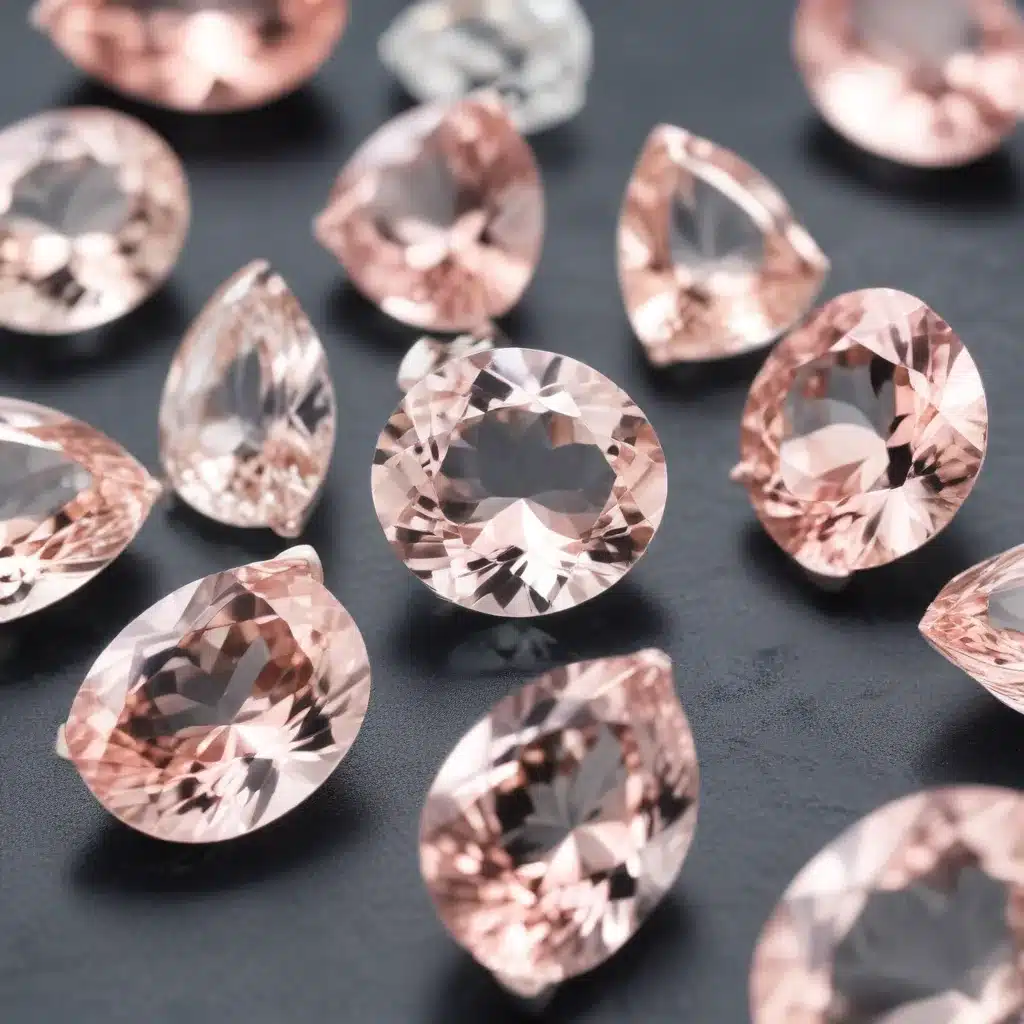
Capturing the warmth and allure of a sunset, morganite is a breathtaking gemstone that has gained popularity in recent years as a sophisticated alternative to traditional diamonds. This delicate member of the beryl family, known for its soft pink to peach hues, offers a unique and ethically-sourced option for those seeking a truly special piece of jewelry. In this in-depth exploration, we’ll dive into the captivating world of lab-grown morganite, uncovering its natural properties, sustainable production, and endless design possibilities.
Morganite Gemstone Characteristics
Morganite Composition and Properties
At its core, morganite is a beryllium aluminum silicate with the chemical formula Be₃Al₂(SiO₃)₆. This gemstone’s distinctive coloration is attributed to the presence of trace amounts of manganese, which imbues the crystal with its alluring pink to peach hues. Morganite’s alluring pastel tones can range from delicate blush to vibrant coral, making it a versatile choice for a wide array of jewelry styles.
Morganite Crystal Structure
The crystalline structure of morganite is characterized by hexagonal symmetry, with each beryllium atom bonded to four oxygen atoms. This precise arrangement creates the gem’s renowned vitreous luster and impressive refractive index of 1.577 to 1.585, allowing it to captivate the eye with its brilliant sparkle.
Morganite Hardness and Durability
On the renowned Mohs Hardness Scale, morganite ranks at a respectable 7.5 to 8, making it a relatively durable gemstone suitable for everyday wear. However, it is essential to note that morganite is still considered a moderately soft gem and requires proper care and handling to maintain its pristine condition. With mindful use and occasional repolishing, a morganite jewelry piece can retain its beauty for years to come.
Lab-Grown Morganite Production
Synthetic Morganite Cultivation
Harnessing the power of modern technology, lab-grown or synthetic morganite has emerged as a sustainable and cost-effective alternative to its natural counterpart. These gems are cultivated using a hydrothermal growth process, which mimics the natural conditions in which morganite forms deep within the Earth’s crust. The result is a gemstone that is chemically, optically, and physically identical to its natural counterpart, yet produced with a fraction of the environmental impact.
Morganite Gemstone Quality Control
The production of lab-grown morganite is meticulously monitored to ensure consistent quality and superior clarity. Advanced analytical techniques, such as spectroscopic analysis and X-ray diffraction, are employed to verify the gem’s authenticity and ensure it meets the rigorous standards demanded by the jewelry industry. This level of quality control guarantees that each lab-grown morganite is a true masterpiece, worthy of the most discerning collector or jewelry enthusiast.
Environmental Benefits of Lab-Grown Morganite
In contrast to the resource-intensive and often environmentally damaging process of natural gem mining, lab-grown morganite offers a sustainable and eco-friendly alternative. By eliminating the need for extensive excavation and reducing the carbon footprint associated with transportation and processing, synthetic morganite production significantly minimizes its impact on the planet. This commitment to environmental responsibility aligns perfectly with the growing demand for ethically sourced and socially conscious jewelry.
Morganite Jewelry Applications
Morganite Engagement Rings
One of the most popular applications for morganite is in engagement rings. The gem’s delicate hues and elegant appearance make it a stunning choice for those seeking a unique and meaningful alternative to traditional diamond rings. Morganite’s softness and relative affordability also make it an accessible option for couples on a budget, without compromising on the beauty and symbolism of an engagement ring.
Morganite Pendant Designs
Morganite’s versatility extends beyond engagement rings, shining equally well in pendant and necklace designs. The gem’s pastel tones pair beautifully with rose gold or white gold settings, creating a timeless and feminine aesthetic. Whether set in a simple solitaire or complemented by a halo of sparkling diamonds, a morganite pendant is a captivating way to showcase this remarkable gemstone.
Morganite Earring Styles
For those seeking a more substantial morganite presence, stud earrings and drop earrings offer a striking option. The gem’s inherent brilliance and unique coloration make it a head-turning choice, whether displayed in a classic solitaire setting or accentuated by diamond accents.
Sustainability of Morganite Gems
Ethical Morganite Mining Practices
While natural morganite can be sourced ethically from select mines around the world, the environmental impact of traditional gemstone mining remains a concern for many conscious consumers. Lab-grown morganite, on the other hand, is produced in a controlled and sustainable manner, eliminating the need for extensive excavation and ensuring fair labor practices.
Morganite Reuse and Recycling
One of the inherent advantages of lab-grown morganite is its recyclability. Unlike natural gems, which can be lost or damaged over time, synthetic morganite can be easily recut, repolished, and repurposed into new jewelry designs, reducing waste and contributing to a more circular economy.
Carbon Footprint of Morganite Jewelry
The production of lab-grown morganite is a significantly more energy-efficient process compared to the extraction and processing of natural gemstones. By minimizing the carbon emissions associated with transportation, mining equipment, and energy-intensive cutting and polishing, lab-grown morganite offers a sustainable and eco-friendly alternative that aligns with the growing demand for socially responsible jewelry.
In conclusion, lab-grown morganite presents a captivating and ethically-sourced gem option for those seeking a unique and sustainable alternative to traditional gemstones. With its alluring pastel tones, moderate durability, and endless design possibilities, morganite has the power to capture the hearts of jewelry enthusiasts and eco-conscious consumers alike. As the demand for responsible and environmentally friendly jewelry continues to rise, the future of morganite shines brightly as a genuine gem that not only dazzles the eye but also reflects a commitment to a more sustainable future.

